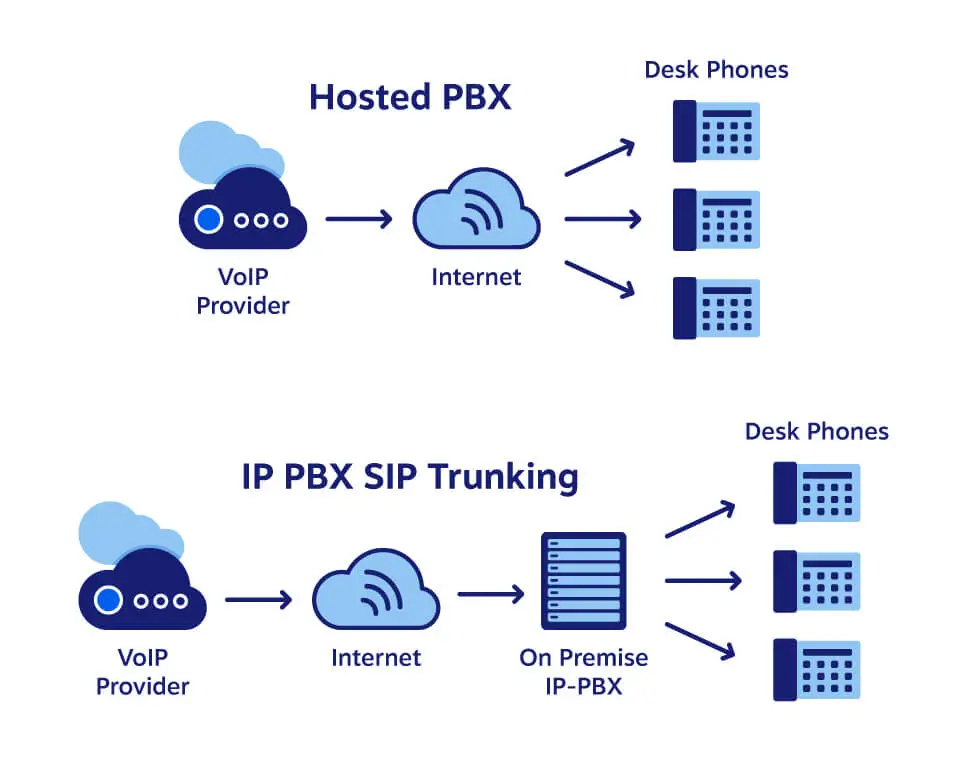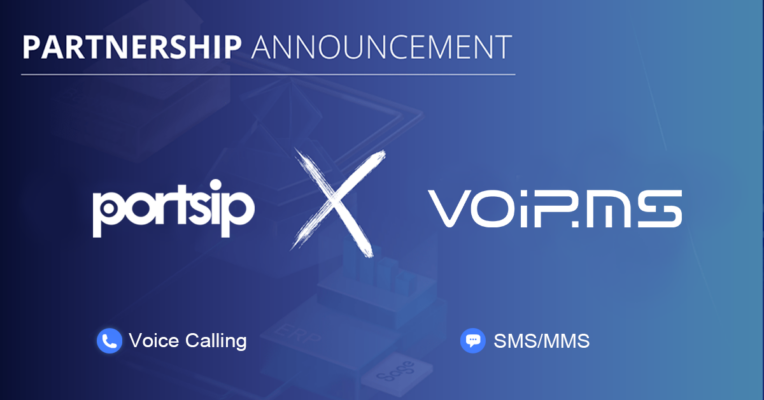IP PBX, also known as a VoIP PBX, Cloud PBX, SIP PBX, or VoIP server, is essentially a business phone system that utilizes a centralized switch system to manage calls to and from the external world. This system replaces the need for multiple individual phone lines, streamlining communication within a business. Despite the varying terminology, all these names refer to the same fundamental concept: a digital telephone system that leverages Internet Protocol (IP) technology for call routing and handling. This modern approach to telephony offers increased flexibility, scalability, and cost-effectiveness compared to traditional PBX systems.
What is an IP PBX?
To understand IP PBX, let’s break down the term. IP, or Internet Protocol, pertains to data transmission between servers. In the context of telephony, calls are established via an internet connection. On the other hand, a PBX, or Private Branch Exchange, serves as your internal business telephone network. It acts as a gateway for incoming and outgoing business phone calls and can be either on-premises or hosted by a VoIP provider.
The primary role of an IP PBX is to manage the call traffic to and from a business premises, as well as internal calls throughout the business’s telephone network. An IP PBX system allows users to share several phone lines and switches calls between VoIP (Voice over Internet Protocol) users. Additionally, an IP PBX system can switch calls between traditional telephone users and VoIP users, much like its legacy counterpart.
One of the key advantages of an IP-based telephone system, as opposed to a traditional PBX that required separate networks for voice and data, is that it operates using converged voice and data networks. This means businesses using an IP solution have internet access, voice calls, and other VoIP communication channels all via a single system. This allows for greater agility, flexibility, and scalability opportunities.

The Evolution of the PBX
A PBX, or Private Branch Exchange, operates much like a switchboard operator. Switchboards made their debut in 1878, just two years after the invention of the telephone. In those early days, only select employees had access to a phone line. When an external call came in, the operator would answer and transfer the caller to the appropriate line. This system allowed offices to separate their telephone network from the rest of the Public Switched Telephone Network (PSTN).
During this era, toll charges were a significant concern. The costs of making phone calls to colleagues and customers, including personal calls, quickly added up. This was a time long before the advent of cell phones.
Fast forward to the 1970s, the PBX evolved in its functionality. It could now automate the routing of calls. Inbound phone calls were answered and “attended” when callers could reach phone extensions directly. Around this time, the emergence of mail-order catalogs with toll-free phone numbers led to a surge in calls with commercial intent.
By the 1990s, automated telephone systems had become standard in the business world. Enterprises began to adopt advanced features like Interactive Voice Response (IVR), call forwarding, caller ID, and Voice over Internet Protocol (VoIP).
Not long after administrators installed a PBX, they began to eye features from the next generation of telecom hardware. Born out of frustration from having to replace proprietary equipment, the hosted PBX started to rise in popularity.
Call centers in the early 2000s pioneered many of today’s PBX features, such as headsets, softphone apps, and call routing. These innovations provided significant cost savings compared to analog phone systems.
How does an IP PBX work?
An IP PBX system operates by receiving and transmitting your outgoing and incoming calls over the internet. Similar to VoIP technology, an IP system achieves this by converting analog voice signals into digital data. These data packets are then directed to a VoIP service provider to initiate and terminate each call.
Generally, an IP PBX uses the universal protocol known as SIP (Session Initiation Protocol), which is commonly used in most business VoIP systems. The use of a PBX requires SIP trunking, a solution that allows for the use of multiple separate lines or voice channels. SIP trunks are utilized to connect desk phones or other hardware to the network. This enables businesses to set up call groups, manage routing, and check voicemails all via their IP-based PBX.
Users of an IP PBX will need a VoIP provider to allocate credentials to the SIP trunking accounts. This ensures that calls can be appropriately directed and received by your business PBX.
Moreover, your IP PBX also manages both internal and external calls, determining whether calls need to be transferred via the PSTN (Public Switched Telephone Network).
Benefits of IP PBX Systems
Adopting an IP PBX system in your business can offer several advantages. Here are some reasons why it’s a smart investment:
Lower Communication Costs – Internet-connected PBX systems can provide significant cost savings compared to their analog counterparts. VoIP providers, such as Nextiva, offer both metered and unmetered trunking services, further enhancing cost-effectiveness.
Cloud-Based Reliability – By connecting your existing PBX to the cloud, you can leverage the proven reliability of cloud technology. A dependable VoIP service will have multiple data centers to ensure consistent performance. Even if your PBX system encounters issues, they can reroute calls to prevent disruptions.
Preserves Existing Hardware – An IP PBX system allows you to maintain productivity and keep hardware costs low by utilizing the same hardware already connected to your PBX. All you need is your SIP address, password, and domain to get started.
Minimal Change Required – Change can be daunting for many businesses. SIP trunking serves as a gateway to experiencing the benefits of a VoIP phone system. As your company grows, you can easily scale up the number of voice channels with minimal configuration.
If you or your IT staff are already familiar with PBX phone systems, an IP PBX could be an intelligent interim solution. Moreover, SIP trunks are location-agnostic, enabling you to get up and running quickly, even if you relocate your offices.
Limitations of IP PBX systems
While IP PBX systems offer numerous advantages, they may not be the ideal solution for every organization. Here are some potential limitations to consider before transitioning to this technology:
Technical Expertise Required – Operating an on-premise PBX system is not a task for the uninitiated. It requires system administrators who are proficient in installing and configuring Linux operating systems. Familiarity with open-source software like FreePBX or Asterisk is essential.
Remote Work Constraints – Despite IP connectivity, many on-premises PBX phone systems do not support remote work. In today’s digital age, this feature is crucial for accommodating remote employees. Ideally, this functionality should be as simple as downloading an app on your Android or iPhone and logging in.
Scalability Limitations – The scalability of an IP PBX system is directly proportional to the number of users available to answer calls. As your team grows beyond the capacity of your PBX system, you may encounter obstacles such as busy signals.
Limited Features – Traditional office phone systems often lack the comprehensive features found in a Unified Communications as a Service (UCaaS) platform. Features like video conferencing, softphones for mobile devices, and instant messaging are typically separate entities. Most small businesses do not have the additional time and resources required to configure these features individually.
Key IP PBX features
Switching from a legacy system to an IP-based PBX brings several advanced features that can benefit business users. If you’re considering a new IP PBX, here are some key features to look for:
1. Voice Messaging: Once considered a ‘nice-to-have’ or an optional add-on, voicemail features are now standard with IP phone systems. For businesses with a dynamic workforce, it may be beneficial to find a system that allows voicemail messages to be sent as an email attachment, either as a transcription or an MP3 file. A system that supports visual voicemail could also be a worthwhile investment.
2. Conferencing: Multi-party conferencing has become a staple in recent times, making it important to find a solution that supports not just simple three-way calling, but also multiple-participant conferencing.
3. VoIP Ready: As telecommunications technology evolves rapidly, it’s natural for businesses to transition away from traditional PBX systems and PSTN lines. Studies have shown that 40% of businesses in the UK alone prefer VoIP. Ensuring that your PBX supports IP stations and IP trunks is crucial as you usher your business into the digital age.
4. Remote Working Capabilities: With remote and home working likely to continue, it’s worth investing in a business phone system that supports this flexibility. Ensure your IP PBX system includes features such as ‘Find Me’, ‘Follow Me’, fixed/mobile convergence, and remote IP extensions to keep your workforce efficient and reachable, whether they’re working remotely or on the move.
5. Reporting and Analytics: Most IP PBX systems now come with basic reporting features built-in, and some may offer more advanced reporting and analytics. Be sure to consider your business requirements when it comes to reporting, and at a minimum, look for a system that includes simple call history reporting.
Types of IP PBX
When you decide to switch from a legacy system, the first step is choosing the right PBX solution for your needs. With several options available, making the right choice can be challenging. Here is a breakdown of the two most common types of PBX suitable for your modern business needs:
1. On-Premises IP PBX: Also known as a VoIP PBX, this system utilizes existing internet connections and internal networks and is located within your office building. It offers more advanced features than a legacy PBX, including advanced call routing, fixed/mobile convergence, interactive voice response, voicemail to email, conferencing, and video calling. An on-site IP system often works best when combined with SIP trunks to deliver better resilience and more stable sound quality over legacy systems. This combination also allows for better business continuity with assets such as disaster recovery.
2. Cloud PBX: Also known as a hosted PBX or virtual PBX, this digital system is hosted in the cloud and owned and managed by a dedicated provider. Operated entirely over the internet, this software-based solution allows users to benefit from the intuitive functionality of a PBX system, but with more scalability for the business and more agility and flexibility for their employees.
With a cloud system, businesses have the ability to choose the platform and telecom service provider, meaning you can select a supplier that you trust to uphold the highest levels of security and resilience for your business phone system. In addition to extensive PBX functionality including voicemail, virtual fax machines, audio conferencing, call recording, and the ability to easily manage and add new phone numbers via an online portal, users can even integrate their phone system with their business CRM and other platforms, enhancing business process efficiency.
One key benefit of investing in a cloud-based system is that the cost is payable to your telephone company in manageable, regular payments without the huge initial outlay on hardware. With a cloud PBX, your business phone features, including phone, fax, messaging, and conferencing, are billed all together, usually as a monthly, manageable cost. Adopting a cloud system also means you’ll benefit from regular maintenance and PBX software updates as part of that cost.
As many forward-thinking businesses seek to adopt a more software-based solution with unified communications platforms becoming increasingly popular for those looking to streamline their business processes, cloud PBX systems are rapidly becoming the solution of choice.
Why Switch to an IP PBX?
Whether you aim to reduce your telephony and communication costs, enhance reliability, scale up, or expand globally, transitioning to an IP PBX is a strategic move. Here are some compelling reasons to consider making the switch:
1. A Manageable, User-Friendly System An IP PBX, whether a cloud solution or an on-site PBX, is managed via a web-based dashboard. This allows both skilled and novice technicians to maintain, customize, and optimize your phone system to meet your specific needs. By managing your own PBX, you can save your IT team’s time and reduce the cost of outsourcing to specialized technicians.
2. Quick and Easy Installation Since an IP system operates as software, it can be installed and configured much faster than hardware-intensive systems. Technicians with basic networking and IT knowledge can install and maintain an IP PBX system, saving you money and minimizing the downtime associated with setting up a new system.
3. Cost-Effective Communications If your business frequently makes overseas calls or incurs high telephony costs, a hosted PBX could significantly reduce your monthly bills. Using a VoIP provider for long-distance or international calls with an IP system can drastically cut your monthly fees. Moreover, if your business operates across multiple sites, you can easily connect the systems, enabling free phone calls between locations.
4. Reduced Office Wiring Adopting a VoIP phone system allows you to plug your phones directly into a standard computer network port. Softphones can be installed onto user PCs, replacing traditional analogue phones. This simplifies the process of adding or changing numbers and extensions for each endpoint. In the event of an office relocation, the need for extensive phone wiring can be eliminated.
5. Scalability If your business has outgrown its legacy on-premises system and you plan to expand, switching to an IP phone solution is worth considering. Whether you’re a small business looking to grow or an international enterprise, an IP system allows you to remain dynamic and add more phone lines and extensions as needed.
6. Enhanced Customer Experience An IP PBX, especially a hosted solution, can support a smoother customer journey. A cloud-based solution integrates your key communication functions with everyday business applications, including calendars, Google Suite, Microsoft 365 tools, and CRM tools like Salesforce. This enables your call center agents and general staff to be more efficient and productive, leading to a seamless customer experience.
7. Consolidated Communication Channels If your business uses a variety of tools and applications for instant messaging, file storage, fax, phone, and video conferencing, consolidating these tools could be beneficial. Unified communications are gaining popularity as businesses aim to streamline processes, reduce the use of disparate applications, and save money by using a single provider for all their communication needs.
8. Improved Mobility With the rise of remote work and the trend set to continue, providing flexibility and agility for your staff is crucial. An IP phone solution enhances mobility. Many providers offer softphones and mobile applications, meaning that with a hosted IP telephony solution, your team members can connect with colleagues and customers from anywhere.
PortSIP PBX Solution Has Your Back

When weighing the solution for hosting the Cloud PBX, you have to look at your needs today and tomorrow. There are, of course, a number of factors to consider when choosing a phone system solution. Pricing is the most obvious one, but there’s also security, flexibility, and scalability.. You have to ask yourself where you want to be in the next year or two and beyond.
Here at PortSIP, we’ll walk you through everything, including free porting of your existing solution. We’ll help you select the right VoIP desk phones that meet your client’s budget and everyday business needs. We cover all of these bases, and its fast deployment means it can be set up in minutes, anywhere in the world. Add phone lines, swap numbers, and more—in real time, then you can run your cloud PBX service like some large service providers, for example, Nextiva, RingCentral, Vonage, and Dialpad.
In the age of the cloud, you cannot keep inching along with a legacy PBX. Your traditional PBX solution costs you more than it’s saving.
Take advantage of the PortSIP Solution and the freedom to work from anywhere. PortSIP PBX lets you focus on serving your customers, not trying to figure out the system. You can leave the rest to us.




